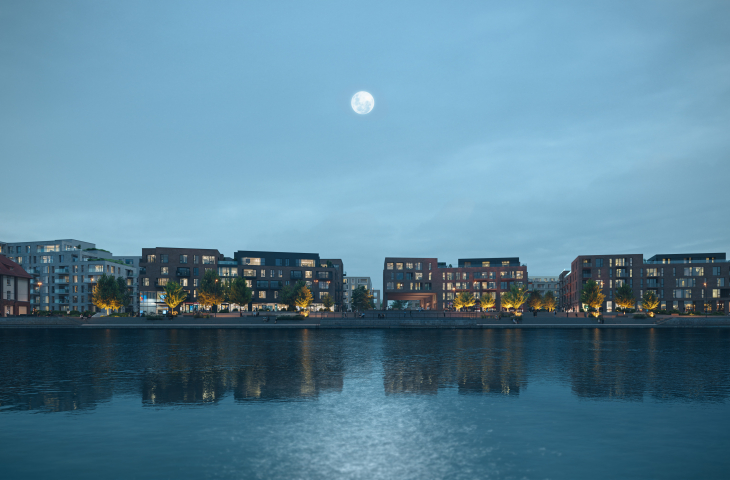The development of the former Gdansk-Klodno train station area, which has been announced for a decade, has begun in Gdansk. The investor, Invest Komfort, announces that in parallel with the apartments, the developer will develop urban spaces: boulevards over the water square and green areas. The project was prepared by BJK Architekci studio, selected in a competition.
The site is located on Torunskaya Street in the Old Suburbs, just a fifteen-minute walk from Dluga Street, and has railroad roots. It was here, in 1852, that Gdańsk's first railroad station, Brama Nizinna (later named Gdańsk-Kłodno), was established. When its function was taken over by the Main Station in 1900, the station ceased to serve passengers, with only freight traffic remaining. In the 1990s, Gdańsk Klodno station was closed, and in 2011 the tracks leading to the Railway Gate were demolished. Three years later, the site was bought back for more than PLN 26 million by Invest Komfort from Gdynia. A local plan is in effect for the site, which allows for residential and commercial buildings from 12 to 23 meters in height.
city square and pedestrian boulevard
The investment waited a long time to begin. Construction started a few months ago, when Invest Komofrt completed another major project on the Motlawa River - the Brabank development in Downtown.
Last week, the developer announced that eventually, as part of six phases of the project called Off Miasto, about a thousand apartments and dozens of commercial units will be built. The successively commissioned parts of the project are to have a variety of architecture and materials. The first stage will include two buildings and a recreational space at the Old Motława waterfront. Opposite the Żabi Kruk marina, a publicly accessible pedestrian boulevard is planned. According to the local plan, a public urban square will also be built.
Off City - new development planned on Torunska Street
mat. Invest Komfort
The design of the development was selected several years ago in a closed urban-architectural competition. At the time, five studios stood in the competition: Arch Deco, BJK, KD Kozikowski Design, Bulanda Mucha and JEMS Architekci. The winner was BJK Architekci, the jury appreciated, among other things, the elegant architecture, the human-friendly nature of the development. Green roofs drew attention.
- From the beginning we worked to create a new part of the city, not just a residential and commercial complex. We wanted to open Off City to Gdansk as much as possible and unite the residential and commercial parts with a greenbelt and water square, as part of the trend of incorporating water into the city," says Tomasz Janiszewski, chief architect and author of the concept from BJK Architekci design office.
The designers add that this resulted in the concept of a cascading building, extending through the boulevards to the bank of the Motlawa River. "Steppedness" of the block, together with a variety of materials, is supposed to give the project dynamics. What's important: traffic will flow along the new street, cars will park underground, and the space between the buildings will be available for pedestrians, not cars.
An estate to live in?
Although there are still many unknowns: the investor has not revealed details of the individual quarters, and it is not known whether and in what part the green roofs proposed in the winning competition entry will be preserved - the new development promises to be promising. All the more so because, as the local portal Trójmiasto.pl was told by Michal Ciomek, vice president of Invest Komfort, "the development is supposed to be a place to live, not to rent to tourists." Short-term rentals are to be discouraged by larger square meters. This is the right direction, especially since there is no shortage of developers in the Lower Town and the Old Suburbs who are tempted to build more apartments for rent.
Interior design of the Off City development
mat. Invest Komfort
Dorota Rudawa of RS Architektura Krajobrazu is responsible for the greenery in the Off Miasto development, while the developer has also invited artist Pawel Nolbert to work with him. The common areas were designed by PB Studio and Akurat studio. The investment will also include the reconstruction of Torunskaya Street and the construction of Jan Ozhzhinsky Street. Divided into stages, implementation of the entire project will take several years.




















